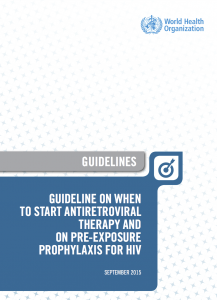New WHO guidelines for when to start ART and use of PrEP (September 2015)
30 September 2015. Related: News.

This article is also included in the September/October issue of HTB.
https://i-base.info/htb/28949
Simon Collins, HIV i-Base
On 30 September 2015, the World Health Organization (WHO) issued a new 78-page guideline document on two important changes to current treatment recommendations. [1, 2]
The first change is that antiretroviral treatment (ART) is to now be recommended for all HIV positive people. Previous guidelines included the option to monitor people in early infection until their CD4 count dropped to 500 cells/mm3.
The second change is that pre-exposure prophylaxis against HIV infection (PrEP) should be widely available to HIV negative people who are at substantial risk of infection, in order to reduce their risk of infection.
 Currently, PrEP is most widely used as a daily pill that contains two HIV drugs (tenofovir DF plus emtricitabine).
Currently, PrEP is most widely used as a daily pill that contains two HIV drugs (tenofovir DF plus emtricitabine).
These recommendations have been announced ahead of the full guidelines which are still in press and expected to be released by 1 December 2015. [3]
Both recommendations are significant for their impact on global health to reduce HIV-related illnesses and deaths and to reduce new infections.
Both recommendations are also controversial in being aspirational goals to drive access to both ART and PrEP, which is still very limited for many people and in many countries.
COMMENT
The lead shown by WHO is based on evidence from clinical studies that show the both benefits of earlier ART and the effectiveness of PrEP.
In practice, the limited access to both ART and PrEP means that this ideal is unlikely to be immediately achieved in any country, however well resourced.
Both changes, together with the publicity that the news will generate, are also likely to contribute to both reducing late and undiagnosed HIV and to normalise HIV by reducing stigma and fear that currently remain high.
In the UK, 40% of the 6250 people diagnosed in 2013 were late – defined as in people whose CD4 count had already dropped to less than 350 cells/mm3.
UK guidelines released this week, already include the recommendation for all HIV positive people to be treated, including at higher CD4 counts.
UK availability of PrEP on the NHS is in the late stages of review, and will be based on the results of the UK PROUD study, that reported PrEP dramatically reduced the risk of HIV infection in gay men and transgender women who were at high risk of HIV infection.
WHO-approved generic formulations of PrEP are easy to buy online at greatly reduced prices compared to the current in-patent version used for HIV treatment. It is legal in the UK to buy online medication for personal use (defined as a three month supply). A recent Q7A on the i-Base website includes further information. [4]
These sites are increasingly being used by people in the UK. This shows the importance for the NHS to provide a setting where the essential monitoring can be easily provided.
- World Health Organization (WHO). Guideline on when to start antiretroviral therapy and on pre-exposure prophylaxis for HIV, (September 2015).
http://www.who.int/hiv/pub/guidelines/earlyrelease-arv/en (web page)
Guideline on when to start ART and PrEP (PDF download) - WHO press release. Treat all people living with HIV, offer antiretrovirals as additional prevention choice for people at ‘substantial’ risk
http://www.who.int/hiv/mediacentre/news/arv-launch-pr/en
- World Health Organization (WHO). WHO consolidated guidelines on the use of antiretroviral drugs for preventing and treating HIV infection. (In press, expected publication: 01 December 2015).
http://www.who.int/hiv/en - i-Base Q&A. Where can I buy PrEP or HCV meds online and is it legal in the UK?
https://i-base.info/qa/10734
